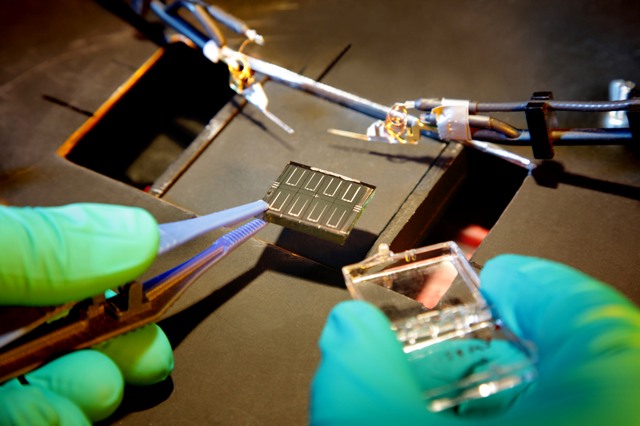Researchers enable solar cells to use more sunlight
March 4, 2015
Scientists of the University of Luxembourg and of the Japanese electronics company TDK have extended sensitivity of a conductive oxide film used in solar cells in the near-infrared region to use more energy of the sun and thus create higher current.
Similar attempts have been made before, but this is the first time that these films were prepared by a one-step process and, at the same time, stable in air, the researchers say.
“The films made at the University of Luxembourg have been exposed to air for one and half years and are still as conductive as when they were fresh prepared,” says Prof. Susanne Siebentritt, head of the laboratory for photovoltaics at the University of Luxembourg.
Transparent conductive oxides are used in devices combining electronics and light, like LEDs, solar cells, and photodetectors. They combine the properties of metals, which are the best electrical conductors known, with those of oxides, which usually are transparent but not conductive, as for example glass. In solar cells the film has to be conductive because it constitutes the upper electrode. At the same time it has to be transparent so sunlight can reach the layer underneath, where the current is formed.
The oxides forming this film can be made conductive by deliberately adding impurities. Zinc oxide with aluminium added is a widely used example. In this case, the aluminum adds free electrons to the zinc oxide, which are responsible for the conductivity. However, these free electrons also absorb infrared light. That means that less sun energy can pass through.
The team of the University of Luxembourg and TDK have modified the process used to make the film to make pure zinc oxide more conductive … [using] a sputter process. This makes the material conductive even without aluminum,” explains Siebentritt.
This method enables fewer, but faster moving free electrons. “With this result, the conductivity is similar to the one with aluminum, but it enables a much better transparency in the infrared region as less free electrons cause also less absorption. That makes solar cells more efficient,” the researchers note.
The findings are published in the journal Progress in Photovoltaics.
Abstract of Highly conductive ZnO films with high near infrared transparency
We present an approach for deposition of highly conductive nominally undoped ZnO films that are suitable for the n-type window of low band gap solar cells. We demonstrate that low-voltage radio frequency (RF) biasing of growing ZnO films during their deposition by non-reactive sputtering makes them as conductive as when doped by aluminium (ρ≤1·10−3Ω cm). The films prepared with additional RF biasing possess lower free-carrier concentration and higher free-carrier mobility than Al-doped ZnO (AZO) films of the same resistivity, which results in a substantially higher transparency in the near infrared region (NIR). Furthermore, these films exhibit good ambient stability and lower high-temperature stability than the AZO films of the same thickness. We also present the characteristics of Cu(InGa)Se2, CuInSe2 and Cu2ZnSnSe4-based solar cells prepared with the transparent window bilayer formed of the isolating and conductive ZnO films and compare them to their counterparts with a standard ZnO/AZO bilayer. We show that the solar cells with nominally undoped ZnO as their transparent conductive oxide layer exhibit an improved quantum efficiency for λ > 900 nm, which leads to a higher short circuit current density JSC. This aspect is specifically beneficial in preparation of the Cu2ZnSnSe4 solar cells with band gap down to 0.85 eV; our champion device reached a JSC of nearly 39 mAcm−2, an open circuit voltage of 378mV, and a power conversion efficiency of 8.4 %. Copyright © 2015 John Wiley & Sons, Ltd.
